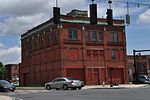The history of Springfield, Massachusetts dates back to the colonial period, when it was founded in 1636 as Agawam Plantation, named after a nearby village of Algonkian-speaking Native Americans. It was the northernmost settlement of the Connecticut Colony. The settlement defected from Connecticut after four years, however, later joining forces with the coastal Massachusetts Bay Colony. The town changed its name to Springfield, and changed the political boundaries among what later became the states of New England. The decision to establish a settlement sprang in large part from its favorable geography, situated on a steep bluff overlooking the Connecticut River's confluence with three tributaries. It was a Native American crossroad for two major trade routes: Boston-to-Albany and New York City-to-Montreal. Springfield also sits on some of the northeastern United States' most fertile soil.Springfield flourished for the decades after its founding, operating as a trading post surrounding by numerous colonial farmsteads. The nearby Indian tribes were gradually displaced by colonial settlement and by the late 17th century became gradually confined to a palisaded fort on Long Hill. During King Philip's War, a pan-tribal effort to expel the colonists from their settlements in New England, a successful Indian attack on Springfield destroyed the settlement. After being rebuilt, Springfield's prosperity waned for the next hundred years but, in 1777, Revolutionary War leaders made it a National Armory to store weapons, and in 1795 it began manufacturing muskets. Until 1968, the Armory made small arms. Its first American muskets (1794) were followed by the famous Springfield rifle and the revolutionary M1 Garand and M14s. The Springfield Armory attracted generations of skilled laborers to the city, making it the United States' longtime center for precision manufacturing (comparable to a Silicon Valley of the Industrial Revolution). The Armory's near-capture during Shays Rebellion of 1787 was among the troubles that prompted the U.S. Constitutional Convention later that year.Innovations in the 19th and 20th centuries include the first American English dictionary (1805, Noah Webster), the first use of interchangeable parts and the assembly line in manufacturing (1819, Thomas Blanchard), the first American horseless car (1825, again Thomas Blanchard), vulcanized rubber (1844, Charles Goodyear), the first American gasoline-powered car (1893, Duryea Brothers), the first American motorcycle company (1901, "Indian"), an early commercial radio station (1921, WBZ), and most famously, the world's third-most-popular sport of basketball (1891, Dr. James Naismith).






